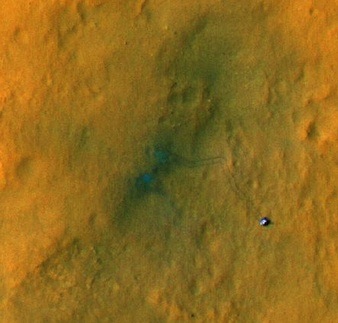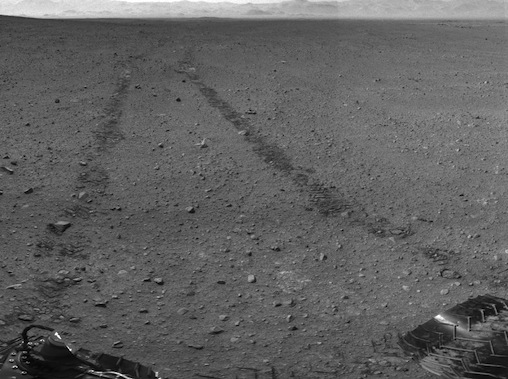After a month on the surface of Mars, NASA rover Curiosity has driven more than the length of a football field and has started gearing for some real scientific work.
"We've been on the surface of Mars for about a month and Curiosity continues to surprise us with how well she's doing with everything we've asked off her," said Mike Watkins, a mission systems manager at NASA's Jet Propulsion Laboratory (JPL). "Now that [Curiosity has] moved, we've reached a point where we want to do a more detailed check of the arm and the tools on it."

Tracks from the first drives of the Curiosity rover are visible in this image captured by the High-Resolution Imaging Science Experiment (HiRISE) camera on NASA's Mars Reconnaissance Orbiter. The rover is seen where the tracks end. The image's color has been enhanced to show the surface details better. (Image: NASA/JPL-Caltech/Univ. of Arizona)
During a press conference Thursday, NASA showed off images of the tracks left by Curiosity after its first trek of 358 feet, which leaves it some 269 feet from the landing site.
Curiosity is now heading toward Glenelg, an area of scientific interest because of three different types of terrain that meet there.
At this point, though, the rover is spending about a week in one spot so scientists can run detailed tests of Curiosity's robotic arm.
On Saturday, scientists will start moving the arm, which has five robotic joints, into various positions to make sure it wasn't damaged during its journey from Earth, or during its descent and landing on Mars, said Matt Robinson, lead engineer for Curiosity's robotic arm at JPL.
The team will also use the arm to take pictures of the area and the rover itself, including the first images of the machine's underbelly since it left Earth.
Robinson also noted that the team will test various tools that are attached to the end of the arm. The tests will include firing up the drill, the arm's dust removal tool and its hand-held imager.
Joy Crisp, deputy project scientist for Curiosity, said today that the rover has taken measurements of the atmosphere on Mars. The rover used its Sample Analysis at Mars (Sam) instrument to test for the concentration of different gases.
The results of those tests could come as early as next week, Crisp said.
Crisp noted today that once Curiosity once again picks up its trek to Glenelg, scientists are hoping to find some interesting rocks along the way.
If they find a fine-grained rock that is embedded in the ground and has a horizontal surface, they'll stop and study it. However, scientists figure they won't use the rover's drill until it reaches Glenelg.
The car-sized, nuclear-powered machine is on what NASA hopes will be at least a two-year mission.
It is equipped with 10 scientific instruments and offers the most advanced payload of scientific gear ever used on the surface of Mars, including chemistry instruments, environmental sensors and radiation monitors.

This scene shows the wheels and track marks left by the rover Curiosity as it drove on the surface of Mars. For scale, Curiosity leaves parallel tracks about 9 feet apart. (Image: NASA/JPL)





